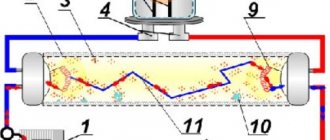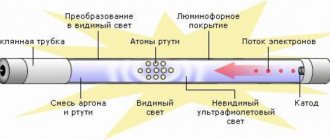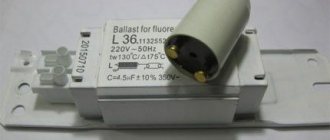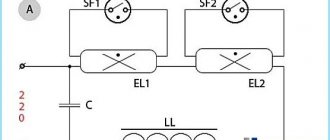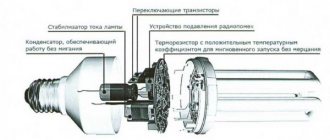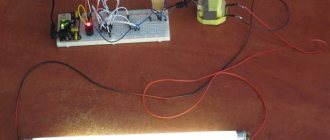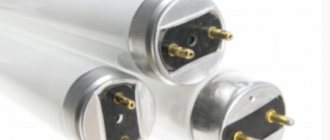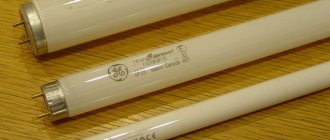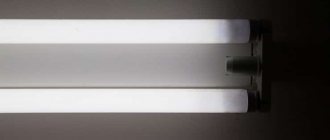The starter, along with the throttle, is one of the most important elements that is used to connect fluorescent lamps. It is a neon lamp of small dimensions; its electrodes are made of a composite type of metal, the structure of which contains several layers of different compositions.
The need for this element is due to the following important functions that it performs:
- Closing the circuit , which is necessary to generate an increased electric current, with the help of which the lamp electrodes are heated. This effect greatly simplifies and speeds up the ignition process.
- Electrical circuit break , which is necessary after the electrodes have been heated. This provokes the appearance of a special pulse with increased voltage, which allows breakdown of the gas gap.
In other words, starters are designed to ignite fluorescent lamps, regardless of the design features of the lighting fixtures, but their implementation in the overall circuit is possible only if it contains an electromagnetic choke.
These devices can be used in electrical networks with an operating frequency of 50-60 Hz with a voltage of 220V or lower.
Design and principle of operation
All starters used for fluorescent lamps have a similar device, which looks like this:
- The device itself is a small-sized gas-discharge lamp that uses the glow discharge principle during operation.
- The flask is most often made of glass and contains an inert gas inside. In modern versions it can be neon or a mixture of hydrogen and helium.
- The flask is placed in a housing that performs protective functions; it is made of metal or durable types of plastic.
- The top cover of the housing can be equipped with an inspection window, if the design provides for its presence.
- The starter is equipped with two electrodes , which are made of bimetal; their design may differ for different models.
- Additionally, the design always contains a capacitor , which is capable of not only smoothing the closing moment and opening the contacts of the device, but also extinguishing the arc that forms between the contacts at the same time. Without a capacitor, there is a risk of welding the electrodes with an arc, which significantly reduces the service life of the starter.
The operating principle of such a device is as follows:
- Initially, both electrodes included in the starter design are in the open position.
- After connecting to the power supply network, a glow discharge occurs inside the device, the current value of which varies from 20 to 50 mA.
- The resulting discharge affects the bimetal electrodes, gradually heating them.
- The heating material provokes bending of the starter electrodes, which helps to stop the discharge and subsequent closure of the electrical circuit.
- Electric current begins to move through a closed circuit, it helps to heat the inductor and cathodes of the fluorescent lamp.
- Due to the disappearance of the glow discharge , the bimetallic electrodes begin to gradually cool down after a certain time. As a result of these changes, their extension occurs, which provokes chain rupture.
- The perfect action contributes to the generation of a pulse with a high voltage value, which acts on the throttle.
- The choke has a significant degree of inductance , so such an effect contributes to the ignition of the lamp.
- The glow of the lamp gradually increases and at the same time it begins to take large amounts of voltage from the electrical network. The starter has a connection parallel to the lamp, so it begins to lack power so that it can create a new glow discharge. Thanks to this, the electrodes subsequently remain in an open state.
Why do you need a starter and a choke in circuits for switching on fluorescent lamps?
The main elements of the circuit for switching on a fluorescent lamp with an electromagnetic ballast are a choke and a starter. The starter is a miniature neon lamp, one or both electrodes of which are made of bimetal. When a glow discharge occurs inside the starter, the bimetallic electrode heats up and then bends and short-circuits with the second electrode.
After voltage is applied to the circuit, current does not flow through the fluorescent lamp, since the gas gap inside the lamp is an insulator, and to break it down a voltage greater than the voltage of the supply network is required. Therefore, only the starter lamp lights up, the ignition voltage of which is lower than the mains voltage. A current of 20 - 50 mA flows through the inductor, the electrodes of the fluorescent lamp, and the neon lamp of the starter.
The starter consists of a glass cylinder filled with inert gas. Metal fixed and bimetallic electrodes are soldered into the cylinder, having leads passing through the bases. The cylinder is enclosed in a metal or plastic case with a hole in the upper part.
Diagram of the glow discharge starter device: 1 - leads, 2 - metal movable electrode, 3 - glass cylinder, 4 - bimetallic electrode, 6 - base
Starters for connecting fluorescent lamps to the network are available for voltages of 110 and 220 V.
Under the influence of current, the starter electrodes heat up and close. After closing, a current flows through the circuit that is 1.5 times the rated current of the lamp. The magnitude of this current is limited mainly by the resistance of the choke, since the starter electrodes are closed, and the lamp electrodes have little resistance.
Elements of the circuit with a choke and starter: 1 - mains voltage terminals; 2 - throttle; 3, 5 — lamp cathodes, 4 — tube, 6, 7 — starter electrodes, 8 — starter.
In 1–2 s, the lamp electrodes heat up to 800–900 °C, as a result of which electron emission increases and breakdown of the gas gap is facilitated. The starter electrodes cool down, since there is no discharge in it.
When the starter cools, the electrodes return to their original state and break the circuit. At the moment the starter circuit breaks, an e.m. occurs. d.s. self-inductance in the inductor, the value of which is proportional to the inductance of the inductor and the rate of change of current at the moment the circuit breaks. Formed due to e. d.s. self-induction, an increased voltage (700 - 1000 V) is pulsed applied to a lamp prepared for ignition (the electrodes are heated). A breakdown occurs and the lamp begins to glow.
Approximately half the mains voltage is applied to the starter, which is connected in parallel with the lamp. This value is not enough to break down the neon light bulb, so it no longer lights up. The entire ignition period lasts less than 10 s.
Consideration of the lamp ignition process allows us to clarify the purpose of the main elements of the circuit.
The starter performs two important functions:
1) short-circuits the circuit in order to heat the lamp electrodes with increased current and facilitate ignition,
2) after heating the lamp electrodes, it breaks the electrical circuit and thereby causes an increased voltage pulse, which ensures breakdown of the gas gap.
The throttle performs three functions:
1) limits the current when the starter electrodes are short-circuited,
2) generates a voltage pulse to break down the lamp due to e. d.s. self-induction at the moment of opening the starter electrodes,
3) stabilizes the combustion of the arc discharge after ignition.
Pulse ignition circuit of a fluorescent lamp in operation:
Connecting fluorescent lamps via starter
Connecting lamps with a choke or ballast initially assumes the presence of a starter in the circuit. A similar example will be considered below; a lamp with a power of 36-40W, a choke with the same characteristics and a starter with a power rating of 4-65W were used for it.
The connection itself looks like this:
- The design of the lamp has output contacts, which are the leads of the bulb's filament; they look like small protruding pins. They require parallel connection of the starter.
- During this process, one contact must be activated on each side of the lamp.
- After this, free contacts remain, which are necessary to connect the inductor through them. It must also be connected in parallel to the mains.
- The last capacitor to be connected in this circuit is connected in parallel with the lamp power contacts. The presence of this element is necessary to eliminate interference occurring in the network, as well as to perform reactive power compensation.
There are 2 connection methods, which are fundamentally different from each other, they depend on the number of lamps:
- A circuit with one lamp involves connecting the inductor and the lighting source itself in series to the power supply; the starter is installed in parallel with the lamp. A capacitor can be installed at the lamp input terminals, which, during the operation of the circuit, will be responsible for improving the parameters of the electric current.
- When implementing a circuit with several lamps, you will need to connect all the lamps and the inductor in series to the power supply. After this, starters are connected in parallel to each of the lamps. An important condition: the total power of these devices must be equal to the power indicator that the throttle itself has.
Execution options
There is a wide variety of electroluminescent lamps, but they can all differ in:
- form of execution;
- type of ballast;
- internal pressure.
The design can be the same as that of conventional fluorescent lamps - a linear tube or a tube in the shape of the Latin letter U. Compact options have been added to them, made to fit a familiar base using various spiral bulbs.
Ballast is a device that stabilizes the operation of the product. Electronic and electromagnetic types are the most common connection schemes.
The internal pressure determines the area of use of the products . Low-pressure lamps or energy-saving samples have been used for domestic purposes or public places. In industrial premises or places with reduced requirements for color rendering, high-pressure units are used.
To assess the ability of lighting, an indicator of the lamp power and its light output is used. Many more different classification parameters and design options can be given, but their number is constantly increasing.
Types of starters for fluorescent lamps
Several different types of starters have been developed, but only one type has become widespread, the operating principle of which is based on a glow discharge.
Such devices have several different classifications, one of the main ones divides them according to the structural features of the electrodes:
- In the asymmetrical variety, one of the electrodes always remains in a fixed and motionless state. In this case, the second electrode can always move and several different metals are necessarily used as the material for its manufacture.
- A symmetrical variety in which both electrodes are of bimetallic origin. This type of starter is used much more often today, since it is much more profitable than its asymmetrical counterpart.
Also, in other cases, the classification of starters can be carried out depending on the following factors:
- The power of the lamps that the device must light, usually this parameter varies from 4-22V to 80-140V.
- Leading manufacturers engaged in the production of starters for lamps. Today, the leaders are Phillips, Narva, Osram and General Electric.
- Popular models taking into account their features.
Operating principle
The action of the starter is inextricably linked with the operation of the entire fluorescent lamp and occurs in the following order:
- Before starting work, the electrodes are open.
- After applying voltage from the network, a glow discharge occurs inside the flask with current parameters of 20-50 mA.
- The discharge begins to act on the bimetallic electrodes, gradually heating them up.
- Under the influence of heating, the electrodes bend, after which the glow discharge stops and the electrical circuit inside the lamp is closed.
- An electric current begins to flow through a closed circuit, heating the inductor and the cathodes of the lamp itself.
- After the glow discharge ceases, gradual cooling of the bimetallic electrodes begins. As a result, they open, unbend and the chain breaks.
- All previous actions led to the appearance of a high pulse voltage acting on the inductor. The inductor itself has inductance, under the influence of which the lamp begins to light.
- Gradually the lamp glow increases and reaches normal. Since the starter is connected in parallel with the lamp, it no longer has enough voltage to create a new glow discharge, since all the current is spent on maintaining the glow. Therefore, the electrodes remain open, but the lamp still continues to work.
Operating principle of a fluorescent lamp
How does a fluorescent lamp work? First, freely moving electrons are formed. This occurs when the AC power supply is turned on in the areas around the tungsten filaments inside the glass cylinder.
These filaments, by covering their surface with a layer of light metals, emit electrons as they heat up. The external supply voltage is not yet sufficient to create an electron flow. As they move, these free particles knock out electrons from the outer orbits of the inert gas atoms that fill the flask. They are included in the general movement.
At the next stage, as a result of the joint work of the starter and the electromagnetic choke, conditions are created for an increase in current strength and the formation of a glow gas discharge. Now comes the time to organize the light flux.
The moving particles have sufficient kinetic energy necessary to transfer the electrons of the mercury atoms, which are part of the lamp in the form of a small drop of metal, to a higher orbit. When an electron returns to its original orbit, energy is released in the form of ultraviolet light. Conversion to visible light occurs in a layer of phosphor covering the inner surface of the bulb.
Why do you need a choke in a fluorescent lamp?
This device works from the moment of start and throughout the entire glow process. At different stages, the tasks performed by it are different and can be divided into:
- turning on the lamp;
- maintaining normal safe mode.
At the first stage, the property of the inductor is used to create a voltage pulse of large amplitude due to the electromotive force (EMF) of self-induction when the flow of alternating current through its winding stops. The amplitude of this pulse directly depends on the magnitude of the inductance. It, summed with the alternating mains voltage, allows you to briefly create a voltage between the electrodes sufficient for a discharge in the lamp.
When a constant glow is created, the choke acts as a limiting electromagnetic ballast for the low-resistance arc circuit. Its goal now is to stabilize operation to prevent an arc fault. This uses the high inductive reactance of the alternating current winding.
Operating principle of a fluorescent lamp starter
The device is designed to control the process of putting the lamp into operation. When the mains voltage is initially connected, it is completely applied to the two starter electrodes, between which there is a small gap. A glow discharge occurs between them, in which the temperature increases.
One of the contacts, made of bimetal, has the ability to change its size and bend under the influence of temperature. In this pair, it serves as a moving element. An increase in temperature leads to a rapid short circuit between the electrodes. Current begins to flow through the circuit, which leads to a decrease in temperature.
After a short period of time, the circuit breaks, which is a command for the self-induction EMF of the inductor to come into operation. The subsequent process was described above. The starter will only be needed the next time it is turned on.
Parameters and markings
When choosing a starting device, you need to pay special attention to its parameters and technical characteristics:
- Service life established by manufacturers. The leaders in this indicator are Osram and Phillips, whose products can withstand at least 6 thousand on and off cycles. However, in practice, this parameter is not always observed for objective reasons, for example, due to surges in mains voltage.
- Operating temperature range. Usually set within 5-55C. If you need to use luminaires outside the established standards, then for these cases you will need special starters with a much higher cost.
- The time period during which the cathodes are fully heated. This factor determines the period that the bimetallic electrodes are in the closed position. This indicator may vary significantly among different manufacturers.
- Varieties and modifications of capacitors involved in a particular device. The service life of the device largely depends on its design.
- Rated operating voltage. This characteristic must be checked, since a device designed for 127 V and connected to a 220 V lamp will immediately fail.
All parameters are displayed on the device label. For domestic devices it looks like this:
- The letter "C" indicates that it belongs to the starter category.
- The numbers in front of the letter “C” indicate the power of the lamp for which this starter is intended.
- The numbers behind the letter “C” correspond to the operating voltage parameters, for example, 127 or 220.
Thus, the marking 60C-220, given as an example, indicates a device that is a starter for a 60 W fluorescent lamp operating on a 220 V network.
Choosing a starter: what to look for
The most common criteria consumers use to purchase lighting items for their home are manufacturer and price. Such parameters are important, but it is not always possible to choose a suitable design solution for a device, guided only by these points. When purchasing a starting element, you should pay attention to:
- Rated voltage. For a connected two-lamp system, a starter designed for 127 V is suitable. If the connection system is single-lamp, we will use a 220 V starter. This is indicated in the markings.
- Power. Depending on the power level of the lamps, it is customary to distinguish between starting devices, which also have different power indicators.
- High quality case. The main parameter is fire resistance. Since the design of the element does not exclude the possibility of fire due to an electric arc or overheating.
- Lifetime. This parameter is assessed differently by different manufacturers. For example, the service life of Philips starters, under normal operating conditions indicated on the packaging, implies a possible number of lamp starts exceeding 6,000 times.
- Duration of the closed state of the electrodes or cathode heating time. The spread in the values of this characteristic among different manufacturers is significant.
- Capacitor type.
Worth remembering! The labeling of domestic manufacturers differs from foreign ones.
Basis of marking according to GOST:
- The letter "C" is for starter.
- The numbers before “C” are the power of the light source (60 W; 90 W or 120 W).
- The numbers after are the voltage (127 V or 220 V).
Foreign markings:
- For lamps with a power from 4 W to 80 W and with a voltage rating of 220 V, starters are designated: S10; FS-U; ST 111.
- For light bulbs with a power of no more than 22 W and a voltage of 127 V, the starters are marked: S2; FS-2; ST 151.
Note! Markings in accordance with GOST of such parts for LDS are given on the starter body.
There are quite a lot of manufacturers of similar elements of the starter lamp ignition system. The main point that the buyer should pay attention to when choosing a model is the compliance of all technical characteristics with the prescribed profile parameters of GOST.
Checking the technical condition of the starter
In the event of any malfunction of a lighting device with fluorescent lamps, it is often necessary to separately check the functionality of the starter. In the general design, it is defined as a fairly simple part with small dimensions. A breakdown of the starter brings a lot of problems, primarily related to the cessation of operation of the entire lamp.
A common cause of malfunction is a worn glow lamp or bimetallic contact plate. Externally, this manifests itself as a refusal to start or flashing during operation. The device does not start either on the second attempt or on subsequent attempts, since there is not enough voltage to start the entire lamp.
The simplest way to check is to completely replace the starter with another device of the same type. If after this the lamp turns on normally and works, then the problem was in the starter. In this situation, measuring instruments are not required, however, in the absence of a spare part, you will have to create a simple test circuit with a serial connection of the starter and an incandescent lamp. After that, connect 220 V power through the outlet.
For such a scheme, low-power light bulbs of 40 or 60 watts are best suited. After switching on, they light up and then periodically turn off for a short time with a click. This indicates that the starter is working properly and its contacts are working properly. If the light is constantly on and does not blink, or it does not light up at all, then the starter is not working and needs to be replaced.
In most cases, you can get by with just one replacement, and the lamp will work again. However, if the starter is definitely working, but the lamp still does not work, it is necessary to sequentially check the inductor and other components of the circuit.
Ballasts in different circuits with LDS
A circuit with two light sources is built on the same principle; the capacitor and inductor perform the same functions. The lamps are connected in series, each is equipped with a starter. When turned on, both starters begin to close and open. The choke creates a common impulse, which is distributed between the lamps; breakdown occurs, after which the lamps light up.
The described scheme is classic; it uses a starter and a solenoid (standard) choke. The circuit with an electronic ballast operates without a starter, but is not suitable for all lamp models.
In any case, before connecting a fluorescent lamp, you need to make sure that the ballast is selected correctly. The classic throttle has the following features:
- The power of the device must correspond to the lamp, that is, for a 40 W LDS, the same electromagnetic ballast is purchased.
- Some types of choke can be used in different ways, for example, for one 36 W lamp, or for two 18 W lamps. This possibility is indicated in the markings located on the device body.
A lamp that can only work with a choke Source pikabu.ru
- If the choke is designed to work with one LDS, in a circuit with two lamps it will not work, or it will start, but the operation will be unstable (even if they match in power).
Electronic ballasts contain an electronic circuit that provides a starting impulse for the breakdown of the lamp, and after the breakdown performs a limiting function. Electronic chokes have a more complex design, and semiconductors often fail. Therefore, the old circuit with electromagnetic ballast often turns out to be more reliable.
How to choose: types and characteristics
For 2P base, the straightening speed should not be higher than 3 µm. It is advisable that the housing should be made of fire-resistant polycarbonate (optional). For 12 W lighting sources, the contacts should be no more than 2.2 cm long. It is advisable to choose orthogonal capacitors. It is this type of capacitors that will not cause problems with current conduction.
If you need to select a part for a 3P base, first of all, you need to pay attention to the inductance of the part. This parameter should be equal to plus or minus 2.5 Gn. In addition, you can choose the appropriate model by paying attention to:
- light source strength;
- starter type. This parameter depends on the type of throttle (electric, electromagnetic);
- the type of control mechanism that is located in the lamp;
- type of contacts (moving, asymmetrical, etc.);
- glow discharge current parameter;
- manufacturer.
One of the most important points when choosing a light source for fluorescent lamps is the company. A good thing cannot be cheap, so do not spare money on a quality manufacturer. Even consumables (such as a starter must be original and of high quality).
Let's look at the types of starters to understand which one is better and which one will be useful in each individual situation. Let us immediately note that there is no universal starter; everyone has pros and cons and specialization.
Service life, repair and replacement
Prolonged use of the starter causes a decrease in the voltage inside it, which leads to wear. This affects performance, the lamp begins to blink, and then stops starting altogether. This is due to the fact that when the lamp is used for a long time, the glowing charge decreases. If signs of a malfunction appear in the form of a blinking light, it is necessary to replace the faulty element in order to prevent failure of all equipment.
In addition to blinking, wear of the inductor due to overheating of the contacts and breakdown of the fluorescent lamp may occur. In order not to frequently change devices that are unsuitable for operation, you need to purchase high-quality starters that have proven themselves in the lighting market. Installing voltage stabilizers also has a positive effect on increasing the service life of lamps.
Replacing the starter is done as follows:
- turn off the lamp;
- remove the lampshade;
- Unscrew the faulty part counterclockwise;
- Insert the new starter into the groove and turn clockwise until it stops.
Appearance of starters and markings
To choose the right starter, you need to know:
- light bulb start type;
- manufacturer;
- electrical characteristics.
High-quality equipment is produced by Philips, Chilisin, Luxe, Osram. Cheap models of starters quickly wear out or lead to such an action as depressurization of the flask. In this case, the gases with which the lamp is filled begin to emit an unpleasant odor, all of which is also harmful to health. A good manufacturer completes its products with spare parts and gives a long warranty period, up to 6 thousand inclusions. Branded stores offer free replacement. If a defect is detected, branded stores will replace the part unsuitable for work free of charge.
Philips is considered the best manufacturer of starters. They are made from high quality materials. For example, heat-resistant polycarbonate is used to protect against overheating. The defect rate is 0.0001%. There are no radioactive components in the models of this company. Simple design and maintenance allow even an inexperienced person to install and replace equipment; you just need to follow the instructions.
Starters from this company are manufactured in the Netherlands. Model S2 is designed for low-voltage lamps with a power limit of 4–22 W.
The S10 model is more versatile. It can be used for high-voltage devices without power limitation.
All quality standards are met by domestically produced starters from Osram, which have a fire-resistant housing made of macrolon.
Before selecting a starter from a particular manufacturer, you need to pay attention to the following characteristics:
- life time;
- temperature regime;
- capacitor type;
- Rated voltage.
How to choose a suitable starter, knowing the operating voltage? The marking of domestic devices is regulated by GOST. The first two digits indicate power. The letter “C” is the purpose of the device (starter). The last numbers determine the voltage.
Example: 90C-220. This inscription must be deciphered as follows: the starter is designed for fluorescent lamps with a power of 90 watts and an operating voltage of 220 V.
When choosing imported starters, you should remember that they have different marking standards. For example, the designations S10, ST111 and FS-U indicate that the starter can be used in luminaires with a power range of 4–80 W, the mains voltage should be 220 V.
Popular makes and models
Many well-known manufacturers of lighting equipment are also manufacturers of starters, the most famous are: Philips, Osram, Sylvania and others .
(Netherlands) produces a wide range of products, including starters. The most modern and advanced of them are the series: “Ecoclick Starters”, “Safety & Comfort Starters”, “Green Starters”.
(Russia) produces a wide range of starters for different types and purposes of fluorescent lamps. Some modifications have special advantages over analogues from other manufacturers.
Such devices are considered:
- Starter fuses – DEOS® ST 171, DEOS® ST 172 and DEOS® ST 173;
- Automatic starters – DEOS® ST 172;
- Universal – DEOS® ST 171, DEOS® ST 172 and DEOS® ST 173.
Automatic starters turn off burnt out or faulty lamps and also restart them.
Starters used for special lamps deserve special attention, such as lamps for solariums. This type of equipment, lamps and components is produced (Germany). The company's product range includes electronic starters of varying power, heating time and operating temperature.
Starters are resistant to ultraviolet radiation, voltage 220/240 V, designed for a single switching circuit:
- PureBronze PBS-25, power 4 - 65 W;
- PureBronze PBS-100, power 80 - 100 W;
- PureBronze PBS-160, power 80 - 160 W.
The range of other manufacturers is also wide and varied, which allows you to choose a device according to the requirements placed on it, however, it is important to remember that you should not choose cheap models, because they usually use cheap materials, and this will negatively affect the service life of the device.
Working with the chuck
Lamp sockets can be installed in different ways: horizontally or vertically, in some models at an angle
Since fluorescent lamps illuminate 360 degrees, it does not matter how they are installed in the socket
The luminous flux of LED lamps is directional, so here it is necessary to pay attention to the placement of the slot in the socket. It may happen that the luminous flux of the connected lamps will be directed not downwards, but to the side
In this case, the most universal are rotary type bases. They are suitable for any model of lamps and allow you to adjust the direction of light.
Fluorescent lamps, thanks to their revolutionary characteristics for their time: low energy consumption, high luminous efficiency and long service life, became very widespread.
It is tubular fluorescent lamps that illuminate most schools, hospitals, offices, workshops, etc.; most often they are installed in raster lamps, familiar to everyone.
The main disadvantage of fluorescent lamps is the presence of mercury inside them, the vapors of which are deadly to humans.
But technology does not stand still; its active development has led to the creation of LED lamps, which have surpassed fluorescent lamps in almost all respects. Currently, their only drawback is the cost in comparison with fluorescent lamps, but in terms of the sum of all the characteristics and benefits, and most importantly for safety reasons, they are unrivaled.
It is not profitable to replace old fluorescent lamps entirely with similar LED lamps, at least simply economically; it is better to simply replace the lamps, because manufacturers have long been producing T8 tubular LED lamps for the G13 base and you can install them, leaving the old lamp body, only slightly modernizing it.
To install LED lamps instead of fluorescent ones, it is necessary to slightly modify the lamp, make it simpler, and remove several unnecessary components from the connection diagram. Now I will show in detail how easy it is to do it yourself.
First of all, let's look at the diagrams of standard raster lamps, designed to install four fluorescent lamps, these are most often mounted in Armstrong-type ceilings.
There are only two varieties of them, two different schemes, the first with ballast and starter, is the most common:
The second scheme is more modern, with an electronic ballast:
As you can see, lamps with fluorescent lamps contain various additional equipment inside that is required for their operation. Read more about this in the material – Connection diagram for fluorescent lamps
In modern tubular LED lamps, in particular T8 with g13 socket, the driver necessary for the LEDs to light is already built into the body of the lamp itself and there is no need to install anything additional.
Accordingly, remodeling any fluorescent lamp comes down to dismantling all unnecessary equipment: ballast, starter, electronics, etc. and connecting power directly to the contacts of the LED lamp. For both types of lamps, the connection diagram is common, all green conductors in the diagram are connected to the neutral wire, and all red ones to the phase wire, it should turn out something like this:
Possible faults
When using any lighting source, the question of repairing it and replacing failed elements always arises.
One of the reasons for the fluorescent lamp not igniting may be a faulty starter, the malfunction of which can be expressed as:
- The lamp does not light up;
- There is a glow at the ends of the lamp, but the lamp does not light up.
To replace the starter, you need to perform simple operations:
- Turn off the lamp;
- Remove the lampshade or other protective element of the lamp;
- Remove the faulty element - starter;
- Insert a new device into the base;
- Reassemble the lamp in reverse order;
- Turn on the lamp.
Replacing the starter is not difficult when there is a spare one, but if there is no such thing, then you need to make sure that the one removed from the lamp is exactly the element due to which the lamp does not burn. Its functionality can be checked in a simple way.
It is necessary to turn on the incandescent light bulb in series with the starter and apply voltage to them. If the starter is working, the light will light up and periodically turn off, and a characteristic click will be heard inside the starter. If the light does not light up, or lights up and does not blink, then the starter is faulty and definitely needs to be replaced.
Theoretically, it is believed that the service life of a starter is equivalent to the operating time of the lamp it lights. However, it must be taken into account that with increasing service life of the device, the intensity of the glow discharge voltage for starters of this type decreases, which affects the operation of the latter. However, all manufacturers of fluorescent lamps recommend replacing starters at the same time as replacing lamps.
The feasibility of using a capacitor
The circuit requires a serial connection of the inductor and the lamp, and the starter is connected to the light source in parallel. In addition, the starting device is connected in parallel with the capacitor.
Connection diagram for gas discharge lamps:
In the figure, the starter is designated as St, the capacitor in question is C1, the lamp is L, the inductor is D. This option is not suitable for electronic ballasts (electronic ballasts). The task of capacitor C1 is to reduce the level of interference during the process of closing/opening the contacts of the starting element.
Starter device diagram
The structure of this device is simple:
The figure shows a diagram of the operation of starters. Main elements: 1 – contacts, 2 – fixed electrode, 3 – glass bulb, 4 – movable electrode with a bimetallic plate, 5 – neon lamp base.
How long does a starter last?
In theory, it is believed that the duration of operation of starters is equivalent to the life of the lamp. Over time, the intensity of the glow discharge voltage inside the neon bulb decreases noticeably.
Often, the electrodes of the starting device are closed when the lamp is on. This is another reason why electronic ballasts are better than electronic ballasts.
Review of manufacturers
Many well-known brands under which various types of lighting products are produced (luminaires, lamps, etc.) also produce starters (OKPD code 31.50.42.190).
Imported components - lamp, choke, starter and capacitor
Some of the most reliable manufacturers: Philips, Osram, Sylvania, General Electric. Their cost is slightly higher, but a lamp with a gas-discharge lighting element will function more efficiently.
The connection diagram also provides for the installation of a capacitor, through which the interference that occurs during operation is partially smoothed out. If, over time, some problems are noted during the operation of a lamp with a gas-discharge bulb, the starter must be replaced immediately, since untimely closing and opening of contacts brings the end of service of the lighting element closer.
{SOURCE}
Blitz tips
If necessary, choose a replacement for a failed starter as follows:
- Pay attention to the lamp supply voltage;
- Determine the required power of the device;
- Choose a manufacturer based on pricing policy and required reliability.
Technologies do not stand still. The starter is now mounted directly into the base of fluorescent lamps with a standard socket; these lamps are called “economy lamps”. They are similar in their operating principles to fluorescent lamps, only their appearance is greatly changed.
Connection without ballast
If necessary, gas-discharge light sources can be connected to the power supply without electromagnetic or electronic ballast. The diagram of such a connection is shown below.
Throttleless connection method
To implement such a connection you will need:
- fluorescent lamp - 40 W and incandescent lamp - 60 W (the latter will work as a ballast resistance);
- two capacitors 0.47 uF 400 V (play the role of a multiplier);
- diode bridge KTs404A or similar, you can use four diodes designed for a current of at least 1 A and a reverse pulse voltage of 600 V.
This circuit is inferior in its parameters to connection using an electromagnetic choke and electronic ballasts. It is provided for informational purposes only.
Starters S2
Starters of this type are mainly manufactured by. The rectification coefficient of the models does not exceed 2.5 microns. If we talk about temperature parameters, then it is better not to use them in cold weather. Housings are most often made with polyurethane impregnation. In this case, the legs are used with small heads. Ballasts are standardly installed of the electromagnetic type. The starter choke is directly connected to the capacitor. However, in some models an additional lining is installed. The duration of heating of the cathodes in this situation depends on the power of the lamp. On average, a model of this type costs around 30 rubles.
Model "Deluxe MN"
Another good starter option. "Deluxe MN" is produced for the P3 base.
Model "Deluxe MN"
They have no problem suppressing interference. They are characterized by the following technical characteristics:
- high inductance parameter;
- can be used for powers not exceeding 60 W;
- the rectification coefficient here does not exceed 3.3 microns;
- feedthrough type capacitor;
- failure rate - 0.3%;
- electromagnetic type ballast;
- the choke is capable of withstanding a resistance of 40 ohms.
The Deluxe MN case is made of plastic. This product can be purchased for about 30 rubles.
S10 devices
Starters of this type are mainly manufactured by. If you believe customer reviews, their cases can withstand even extremely high temperatures. However, they are quite sensitive to high humidity. The rectification coefficient itself fluctuates around 3.5 microns. In this case, the inductance indicator does not exceed 5 H.
If we talk about design features, it should be noted that chokes are used with a glow discharge. However, in this case, much depends on the power of the lamp. If we talk about 20 V models, they use neon as a gas. Ballasts for such devices are suitable only of the electromagnetic type. The failure rate depends solely on the quality of the capacitor. Most often they are of the pass-through type. The capacitance of the capacitors fluctuates around 6.5 pF. A good starter for fluorescent lamps of this type costs about 40 rubles.
How does a housekeeper work?
The appearance of fluorescent lamps may vary. Despite this, they have the same operating principle, which is implemented thanks to the following elements that the device circuit usually contains:
- electrodes;
- phosphor - a special luminescent coating;
- glass flask with an inert gas and mercury vapor inside.
The structure of a fluorescent light bulb
This fluorescent lamp is a gas-discharge device with a sealed glass bulb. The gas mixture inside the flask is selected in such a way as to reduce the energy costs required to support the ionization process.
To do this, a voltage of a specific value is applied to the electrodes of the fluorescent lamp. They are located on opposite sides of the glass flask. Each electrode has two contacts that connect to a current source. In this way, the space near the electrodes is heated. The actual connection diagram for this light source consists of a series of sequential actions:
- heating of electrodes;
- then a high-voltage pulse is supplied to them;
- the optimal voltage is maintained in the electrical circuit to create a glow discharge.
As a result, an ultraviolet invisible glow is formed in the flask, which, passing through the phosphor, becomes visible to the human eye. To maintain the voltage to create a glow discharge, the operating diagram of fluorescent lamps involves connecting the following devices:
throttle. It acts as a ballast and is designed to limit the current flowing through the device to an optimal level;
Choke for fluorescent light bulbs
starter. It is designed to protect the fluorescent lamp from overheating. At the same time, it regulates the intensity of the electrodes.
Very often, the cause of breakdown of the housekeepers is the failure of the electronic ballast filling or the burnout of the starter. To avoid this, you can avoid using burnt-out parts in the connection.
Standard connection diagram
The standard circuit used for connecting fluorescent lamps can be modified (go without a choke). This will minimize the risk of failure of the lighting fixture.
Switching option without ballast
As we found out, ballast plays an important role in the design of a fluorescent lamp. At the same time, today there is a scheme in which it is possible to avoid the inclusion of this element, which very often fails. You can avoid turning on both the ballast and the starter.
As you can see, this circuit does not contain a filament. In this case, the lamps/tubes will be powered through a diode bridge, which will create an increased DC voltage. But in such a situation, it is necessary to remember that with this method of power supply, the lighting product may darken on one side. In implementation, the above scheme is quite simple. It can be implemented using old components. For this type of connection you can use the following elements:
- 18 W tube/light source;
- GBU 408 assembly. It will act as a diode bridge;
capacitors with an operating voltage not exceeding 1000 V, having a capacity of 2 and 3 nF.
It must be remembered that the selection of diodes for the diode bridge, as well as capacitors, must be carried out with a voltage reserve. A lighting device assembled in this way will produce a glow slightly less bright than when using the standard connection option using a choke and starter.
Starters
manufactures starters only using helium-hydrogen. In this case, there are many models on the market for P3 sockets. All starters have cylindrical bodies. Fire-resistant impregnation is provided in this case. The legs are directly installed with the heads. The capacitors in the devices are of the orthogonal type. Their capacitance fluctuates around 5 pF.
With interference suppression in starters, gaps occur quite rarely. The average failure rate is 0.2%. Radioactive isotopes are not used in the production of devices. It is also important to mention that the ballasts used are of the electromagnetic type. The average starter for fluorescent lamps from the presented company costs about 35 rubles.
Launch scheme
When the light bulb is connected, you need to make sure that it is correct and that the ballasts are in good working order. To carry out the tests, you need to have a multimeter with which you can check the cathode filament bodies.
The permitted resistance level does not exceed 10 ohms. If the multimeter indicated the resistance as infinite, then there is no need to rush to throw away the lamp. This device is still operational, but it must be used in a cold start system. Now you can try to start the lamp.
Attention! Under normal conditions, the starter wires are open circuit and its capacitor does not allow DC current to pass through. Simply put, the multimeter should show a fairly high resistance, which can be more than 100 ohms
Fluorescent lamp ignition circuit
In conclusion, it should be noted that the fluorescent lamp circuit is quite heavy, which is beyond the power of an ordinary person. But there are many options that make the job much easier.
It is important to remember that children should not be allowed into this type of activity. When installing the lamp, you need to turn off the power to the entire room.
Elements of “ignition” of light
The starter of various modifications ignites light sources that are powered by alternating current mains with a frequency of 50 Hz.
For this purpose, the lamp device has a ballast. In devices with glow discharge, after activation of the light source, increased voltage will begin to flow to the contacts.
The component itself is presented in the form of a small glass flask filled with gas. The flask itself is located in the inner part of the housing made of plastic or metal. In the lower part there is equipment consisting of two electrodes that come into contact with the lamp wires. Some models have a window at the top.
It is worth noting that it is the starters that most often break, after which the lamp cannot be turned on. But replacing them is not difficult if you know how to do it.
This component has the following functions:
- it starts first when connected to the network;
- responsible for heating the electrode;
- increases the current supply to the illuminator;
- closes and opens bimetallic plates;
- transmits current to the inductor.
If a part fails, the lamp simply will not turn on and begin to shine . Moreover, if a direct connection is made, the life of the lighting components is reduced. Starters are selected in accordance with the connection diagram.
Ignition of the starter
The process of emitting glow begins provided that the cathode of the light source is heated to the desired state. In addition, it is important that the level of current applied to the cathode during the return movement of the starter bimetallic plate is high, since, otherwise, a high-voltage pulse of sufficient intensity will not arise in the inductor. If these conditions are not met, the lamp will not turn on.
The operating principle of gas-discharge lamps involves automatic repetition of the initial stage of the switching process (the moment the starter electrodes open). This happens until the lamp starts working. Of course, numerous attempts to light the lamp affect the duration of its operation.
This is one of the reasons why electronic ballasts (EPG) are significantly superior to their electromagnetic counterparts.
How to check if the starter is working properly
Despite the simplicity of the design of the part, its failure can significantly damage the light source.
Important! If you have a faulty lamp with fluorescent light sources, you first need to check the functionality of the starting device.
The easiest way to check such a lamp ignition element is to replace it with a similar device. Replacing the starter is quite simple. If the fluorescent lamp starts working after this, then the cause of its malfunction was precisely the breakdown of the starter.
You can also determine the serviceability of the starter if you have special measuring instruments - a multimeter or tester. The multimeter is much more multifunctional than its analogue (tester).
Selecting a starter for certain technical characteristics of a fluorescent light source is not difficult. The user only needs to be guided by knowledge of the design of the ignition element, as well as understand the features of its mechanical and operational characteristics.
Particular attention should be paid to the marking of the starter, especially the power indicator and rated voltage. The effective performance of the lamp and its service life directly depend on the choice of a high-quality starter.
Electronic starter
The processes occurring in starting devices cannot be controlled. Their performance is greatly influenced by temperature changes in the room. So, if the temperature is below zero degrees, then the heating of the electrodes will be slower, therefore, the device will take more time to turn on the light. In addition, at elevated temperatures, contacts that are soldered to each other may burn out, which will negatively affect the spirals of the lamp. Overheating leads to its failure.
However, despite the seemingly correct functioning of the lamp, it may break sooner or later. Due to the duration of preservation of the incandescent contacts in a lighting device, its production potential decreases. It is precisely to eliminate such a shortcoming in the igniter microcircuit that quite complex systems have been created, which are based on microcircuits. Such designs and circuits simulate the process of closing an electronic type starter.
electronic ballasts
